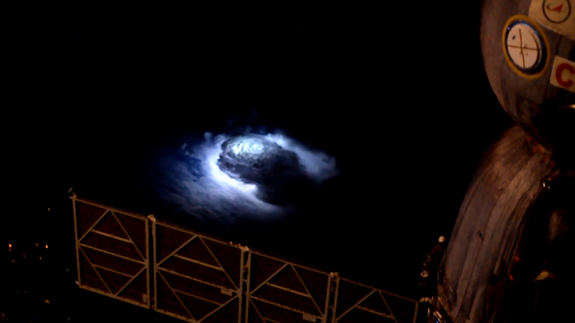Astronaut captures clearest footage yet of rare type of lightning

Generally speaking, storms seen from space are pretty breathtaking.
Lightning flashes, huge thunderheads and the swirling clouds of hurricanes all take on a unique look when seen from the International Space Station orbiting 250 miles above Earth's surface.
SEE ALSO: The first photos from a revolutionary new weather satellite are gorgeous
The Space Station is also an amazing place to check out weather from an angle you aren't afforded on our planet. This includes weather phenomena that have been hotly debated, but poorly observed, such as a type of lightning known as "blue jets."
Danish astronaut Andreas Mogensen did just that during his mission to the station in 2015. Mogensen took photos of thunderstorms using an incredibly sensitive camera onboard the orbiting outpost as part of a research experiment aiming to capture footage of rare weather events seen from above.
It worked!
Mogensen managed to capture a 23-second video showing blue flashes above a thunderstorm over India. The flashes are smaller and dimmer than the typical lightning seen in the footage erupting within the thunderstorms.
This is the clearest footage of blue jets ever captured, according to the European Space Agency (ESA).
And it's beautiful.
"It is not every day that you get to capture a new weather phenomenon on film, so I am very pleased with the result," Mogensen said in an ESA statement.
Mogensen captured the blue jet footage by aiming his camera at pillars of clouds reaching into the upper atmosphere. In 160 seconds of footage, the astronaut managed to capture 245 flashes of blue above the thunderstorm, according to the ESA.
Blue jets, it is thought, erupt upward from a thunderstorm and into the upper atmosphere, and can rarely, if ever, be seen from the ground.
Scientists aren't yet sure how these mysterious blue flashes occur in our upper atmosphere, but a followup study on the Space Station will hopefully help researchers figure it out.
Scientists will launch a new camera to the station before the end of the year that will be mounted on the outside of the space lab to capture photos of thunderstorms as they occur on Earth, possibly unlocking the secrets of blue jets and other mysteries in the upper atmosphere.
